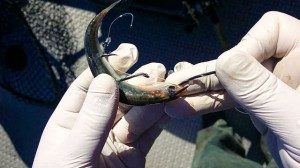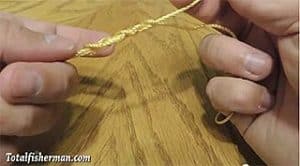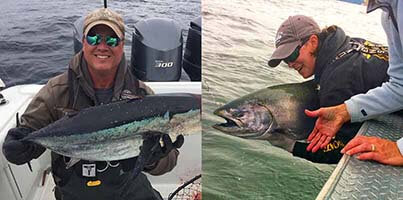Mahi Mahi Fish, Fishing and Information
Posted on by kmnewell
Check out our Astoria Fishing Charters and Washington Halibut Charters
MAHI MAHI
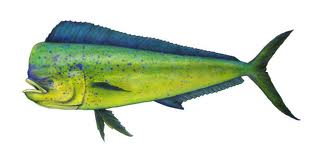
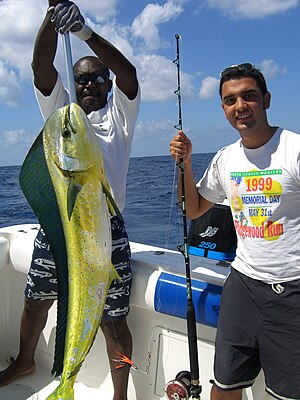
The Mahi-Mahi fish has several other names and is popularly known as – Mahi Mahi, Dorado and Common Dolphinfish.
The Coryphaenidae family is a two member family with the Coryphaena genus, under which the Common Dolphinfish and the Pompano Dolphinfish is classified. The Pompano Dolphinfish like the Mahi Mahi fish have compressed heads and long dorsal fins that extends nearly to the entire length of the body but are smaller in size therefore giving rise to occasions where it is mistaken for a younger Mahi Mahi fish.
Mahi Mahi are extremely agile acrobatic game fish that are found in warm tropical and subtropical waters of the world. These surface dwelling ray finned fish are know for their bright dazzling colors that are difficult to accurately describe because of the rapid color changes it undergoes when it get’s excited. This feature of the Mahi Mahi is what gave rise to its Spanish name, Dorado Maverikos, which literally translates to “Golden Maverick”.
Mahi Mahi is often assumed to be related to mammalian dolphins because of it being referred to as the Common Dolphin fish, however this is not true. The similarity between the two species ends with their name as they are very different both in terms of features and characteristics. Mahi Mahi is actually the Hawaiian name of the Dolphinfish and it means “very strong”. This name has been popularly adapted in many places in order to avoid this confusion.
The male fish of this species are known as bulls while the female fish are known as cows. It is quite easy to differentiate a male fish from the female fish. An identifying feature is the forehead. The forehead of the male fish is protruding and is prominent while the female fish has a rounded head.
The most attractive feature of Mahi Mahi fish is undoubtedly its stunning colors. The dorsal region of the Mahi Mahi is either in a rich iridescent blue or blue green color while the dorsal fin is in rich blue. It’s anal and caudal fin are golden in color while the Pectoral and Pelvic fins are golden yellow with blue edges. Its golden side is sprinkled with dark and light blue spots. The belly region is usually either silvery or yellowish. It is difficult to distinguish the colors once it’s brought out of the water as the color rapidly changes to yellowish grey upon its death. A Mahi Mahi fish with a grey skin is not fit for consumption as the color is an indication of it being spoiled.
Despite the steady increase in fishing pressures the Mahi Mahi population has remained healthy and stable because of it being prolific spawners. Mahi Mahi is one among the fastest growing fishes found in the world and is extremely migratory. They are carnivorous fish and feed on flying fish, crustaceans, squid, mackerel, and other small fish. They are particularly skilled in hunting flying fish. They are also known to feed on zooplankton.

Mahi Mahi is found in all the warm oceans of the world and its commercial value is increasing with time. Around 30,000 to 40,000 tons of Mahi Mahi is being harvested every year around the world with Ecuador, Costa Rica, Japan, and the United States being the largest exporting countries. It is primarily consumed in the United States, Caribbean countries, Japan and Europe.
These fish are one of the favorite saltwater species for sports fishermen. They are preferred over other game fishes because of their unique color and beauty. These fish “light up” when hooked and display hues of neon while trying to free themselves from the hook. Mahi are also available in abundance, which is another plus for fishermen and the fact that these fish are typically large makes the whole fishing experience exciting. Though these fishes on an average weigh 15 to 30 pounds, there have been cases where the fishes have weighed above 50 pounds however such catches are rare. Another reason for the sports fishermen going after Mahi Mahi is because of its fighting spirit. They tend to put up a long fight.
Mahi Mahi have a peculiar habit of being present around marine debris such as palm trees, floating boards or even something as small as a soda can and Sargasso weed lines. An experienced fisherman is able to identify the fish species present near the debris or the Sargasso weed by observing the Frigate birds behavior.

The Frigate bird dives down for small fish that congregate near the debris and hence the Frigate Birds presence can also be used as a strong indicator of the presence of Mahi which also like to eat the same bait fish.
Trolling is the most popular method practiced for catching a Dolphin fish. In this method one or more fishing lines with lures or bait fish are attached to the back of the fishing boat or are slowly released into the water, if not in motion, to catch the fish. Ballyhoo is the commonly used bait fish.
Mahi Mahi exhibit schooling behavior wherein the fish swim in groups in a coordinated manner, in the same direction, in order to form a defense against predators as well as to increase the school’s hunting success. Thus, when a school of Mahi Mahi is encountered, the fish that is caught is often not removed from the water but rather is left swimming near the boat so that the other fish stay close by and can then be hopefully caught. These fishes are then caught using techniques like fly casting.
An interesting technique used in Hawaii involves using kites. The offshore kite fishing technique is a kind of sports fishing method where live baits are used to attract surface dwelling fish such as the Dolphin. This technique is advantageous as it gives access to areas that might not be easy to navigate in boats. In Hawaii this technique has been adopted to catch a variety of fish from ocean side cliffs.
Recreational fishing of Mahi Mahi around North America is predominant along the Pacific Coast, more so in the Gulf of California, off the coast of Costa Rica and offshore in the Atlantic Ocean from New Jersey to Florida. Some of the ideal spots for recreational fishing of Mahi Mahi are Hawaii, Southeast Asia, Gulf of Mexico, Pacific coast of the Caribbean Sea and Costa Rica.

